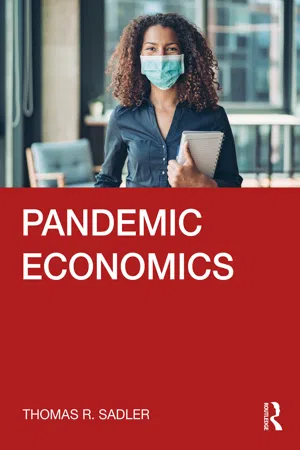
- 320 pages
- English
- ePUB (mobile friendly)
- Available on iOS & Android
Pandemic Economics
About this book
Pandemic Economics applies economic theory to the Covid-19 era, exploring the micro and macro dimensions of the pre-pandemic, pandemic, and post-pandemic phases.
Using core economic tools such as marginal analysis, cost-benefit analysis, and opportunity cost, this book explores the breadth of economic outcomes from the pandemic. It shows that a tradeoff between public health and economic health led to widespread problems, including virus infections and unemployment. Taking an international and comparative approach, the book shows that because countries implemented different economic policies, interventions, and timelines during the crisis, outcomes varied with respect to the extent of recession, process of recovery, availability of medical equipment, public health, and additional waves of the virus.
Pedagogical features are weaved throughout the text, including country case studies, key terms, suggested further reading, and discussion questions for solo or group study. On top of this, the book offers online supplements comprising PowerPoint slides, test questions, extra case studies, and an instructor guide.
This textbook will be a valuable resource for advanced undergraduate and postgraduate courses on pandemic economics, macroeconomics, health economics, public policy, and related areas.
Frequently asked questions
- Essential is ideal for learners and professionals who enjoy exploring a wide range of subjects. Access the Essential Library with 800,000+ trusted titles and best-sellers across business, personal growth, and the humanities. Includes unlimited reading time and Standard Read Aloud voice.
- Complete: Perfect for advanced learners and researchers needing full, unrestricted access. Unlock 1.4M+ books across hundreds of subjects, including academic and specialized titles. The Complete Plan also includes advanced features like Premium Read Aloud and Research Assistant.
Please note we cannot support devices running on iOS 13 and Android 7 or earlier. Learn more about using the app.
Information
1 Introduction to pandemic economics
- LO1 Describe the field of pandemic economics.
- LO2 Discuss the economic approach and its application to the study of pandemics.
- LO3 Analyze the origin of the coronavirus pandemic.
- LO4 Assess the history and economic implications of previous pandemics.
- LO5 Analyze the rules of pandemic economics.
Chapter outline
- Pandemic economics
- The economic approach
- A pandemic origin story
- Previous pandemics and economic history
- Rules of pandemic economics
- Summary
Pandemic economics
The economic approach
Economic methodology
Table of contents
- Cover
- Half-Title
- Title
- Copyright
- Brief Contents
- Detailed Contents
- List of figures
- List of tables
- Preface
- Acknowledgments
- An overview of the book
- Learning objectives
- 1 Introduction to pandemic economics
- PART I INVESTIGATION AND RECOGNITION
- PART II THE PANDEMIC PHASE: SHUTDOWN, RECESSION, AND RECOVERY
- PART III ECONOMIC ANALYSIS OF PANDEMIC OUTCOMES
- Index